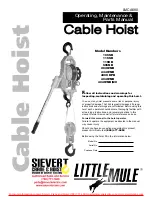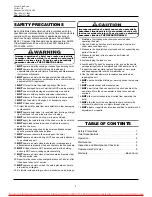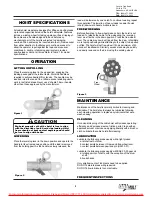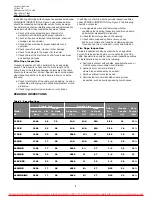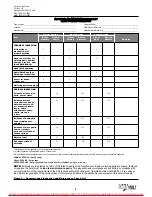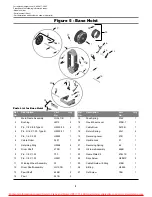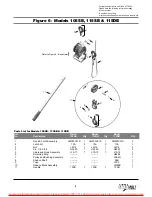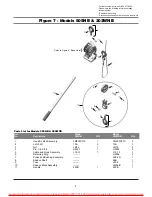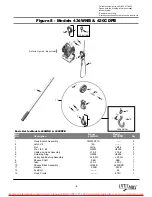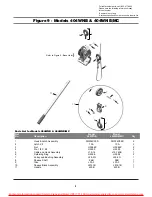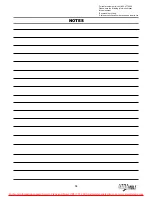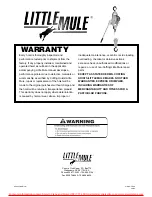
In addition to performing all the frequent inspections listed under
FREQUENT INSPECTION on Figure 4, visual observations
should be conducted during regular service for any damage.
Any deficiencies shall be carefully examined and determination
made as to whether they constitute a hazard as follows:
a. Check all functional operating mechanisms for
maladjustment interfering with proper operation.
b. Check all hooks and latches for deformation, chemical
damage, cracks and wear.
c. Check all hook latches for proper attachment and
operation.
d. Check levers for bends, cracks or other damage.
e. Check for damage to the support for the hoist.
f. Check cable at the start of each shift for abrasive wear
and damaged strands.
Wire Rope Inspection
Frequent inspections shall be performed by an appointed
person. This inspection shall cover the entire length of the
cable. If any of the following damage is discovered, the cable
should be removed from service. Special care should be taken
when inspecting sections for rapid deterioration, such as the
following:
a. Check for distortion of the cable such as kinking, crushing,
unstranding, birdcaging, main strand displacement or core
protrusion.
b. Check for general corrosion, broken or cut strands.
PERIODIC INSPECTIONS
In addition to performing all the periodic inspections listed
under PERIODIC INSPECTION on Figure 4, the following
should be conducted:
a. A designated person shall determine whether
conditions found during inspection constitute a hazard
and whether disassembly is required.
b. Check fasteners for evidence of loosening.
c. Check cable, suspension frame, levers, yokes,
shafts, pins, rollers and locking and clamping devices
for evidence of wear, corrosion, cracks and distortion.
Wire Rope Inspection
Periodic inspections shall be performed by an appointed
person. This inspection shall cover the entire length of the
cable. Special care should be taken when inspecting sections
for rapid deterioration, such as the following:
a. Sections in contact with saddles, equalizer sheaves, or
other sheaves where cable travel is limited.
b. Sections at or near terminal ends
where broken strands may be evident.
c. Sections subject to reverse bends.
d. Sections that are normally hidden during visual
inspection, such as sections passing over sheaves.
3
Country Club Road
P.O. Box 779
Wadesboro, NC 28170 USA
TEL: (800) 477-5003
FAX: (800) 374-6853
Table 1 - Specifications
Single Line
Double Line
Hook
Hook
Cable
Handle
Ship
Model
Capacity
Lift
to Hook
Capacity
Lift
to Hook
Dia.
Length
Weight
No.
(lbs) (ft) (Min.) (in)
(lbs)
(ft)
(Min.) (in)
(In)
(in)
(lbs)
105SB
1000
40
20
N/A
N/A
N/A
3/16
16
12½
115SB
1000
23
20
N/A
N/A
N/A
3/16
16
11½
115DB
1000
23
20
2000
11½
27
3/16
16
14
505NB
1500
17
20
N/A
N/A
N/A
1/4
20
12½
202WNB
1500
17
20
3000
8½
27
1/4
20
14½
434WNB
1500
22
20
3000
11
27
1/4
20
15
430CDPB
1500
22
20
3000
11
30
1/4
20
15½
404WNB
2000
17
20
4000
8½
27
9/32
24
16½
404WNB/MC
2000
17
20
4000
8½
27
9/32
24
16½
For more information contact: Sievert Crane and Hoist, (708) 771-1600, [email protected], www.sievertcrane.com

